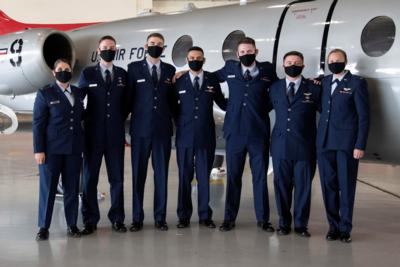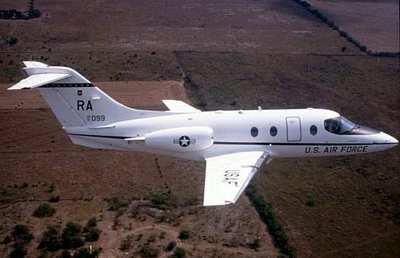Undergraduate Pilot Training Curriculum Only Utilizes One Airframe -- The T-1 Jayhawk
Seven Airmen made history as the first “Accelerated Path to Wings” program graduated and they transitioned from students to Air Force pilots during a ceremony March 12.

Nicknamed the “XPW” program, the course is part of Air Education and Training Command's current pilot training transformation efforts and consists of students completing an undergraduate pilot training curriculum that only utilizes one airframe, the T-1 Jayhawk.
“We had students from various backgrounds, including five who had completed their initial flight training and two who had earned their private pilot’s license,” said Lt. Col. Eric Peterson, 99th Flying Training Squadron commander, “This is a great program for students who want to go fly heavy aircraft in Air Mobility Command, or who want to go fly certain aircraft in special operations or in Air Combat Command.”
Traditional UPT is a three-phase program that produces pilots in 12 months. The XPW program is done in two phases and graduates students in about seven months.
The first phase in XPW includes preflight academics where students learn general aviation terminology, after which students go directly to the T-1 aircraft, skipping the traditional route of flying the T-6 Texan II.

At the 12th Training Squadron’s simulator branch, the students developed extensive training profiles, allowing them to practice and be certified as proficient in the aircraft. Once students make it through the required simulator training, they go on to fly in the T-1 under the guidance of the 99th FTS team.
After receiving their diplomas, the new pilots followed a tradition called breaking of the wings, which originated decades ago when the Army Air Corps first started issuing pilot wings to young graduating aviators.
Graduation day was filled with excitement for 2nd Lt. Kassandra Fochtman, who is headed to McConnell Air Force Base, Kansas, to fly the KC-135 Stratotanker.
“It feels amazing to have endured the last seven months of pilot training to reach this point. It’s all been worth it,” she said. “I’m extremely proud. I can’t wait to begin flying around the world.”
One freshly minted pilot stood out from amongst his peers as he received the Top Stick award, Distinguished Graduate award and the AETC Commander's Trophy.

“Graduating from the first XPW class is pretty special,” said 2nd Lt. Andrew Button, who is slated to fly the C-17 Globemaster III at Joint Base Charleston, South Carolina. “I volunteered for this not knowing if it would work out or not, but I just put my trust in the Air Force. I want to give credit to my family and the world-class instructor pilots at the 99th FTS.”
Col. Robert Moschella, 12th Operations Group commander, served as the guest speaker. “The XPW program is a great way to capitalize on T-1 capacity to produce high quality pilots for the Air Force. These students had a great attitude throughout the program and showed an unrelenting willingness to learn and earn their wings.”
 ANN's Daily Aero-Linx (05.02.24)
ANN's Daily Aero-Linx (05.02.24) ANN's Daily Aero-Term (05.02.24): Touchdown Zone Lighting
ANN's Daily Aero-Term (05.02.24): Touchdown Zone Lighting Aero-News: Quote of the Day (05.02.24)
Aero-News: Quote of the Day (05.02.24) ANN FAQ: Contributing To Aero-TV
ANN FAQ: Contributing To Aero-TV NTSB Final Report: Cirrus Design Corp SR20
NTSB Final Report: Cirrus Design Corp SR20





